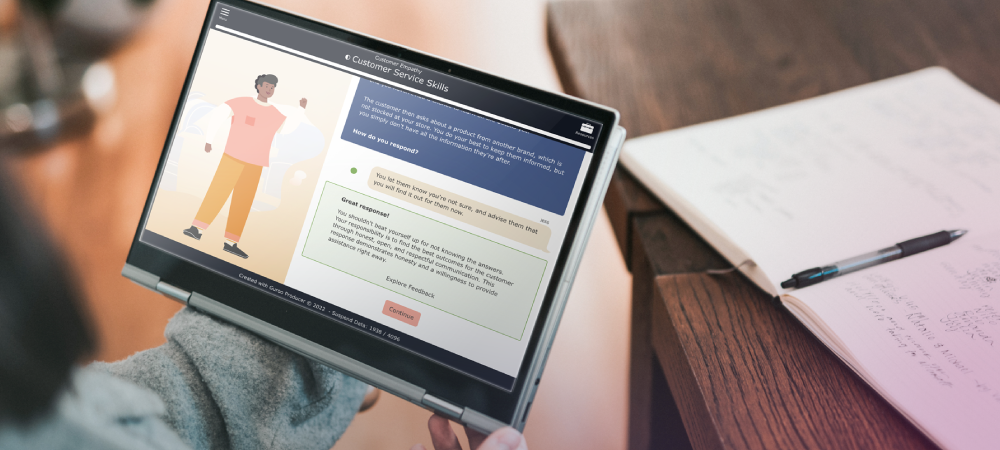It's important to understand that courses are more than just delivering content with the hopes that your learners catch on and will be able to carry this theoretical knowledge into practical, real-world skills. Instead, courses should be unique to each learner's needs and level of knowledge; they should support them and allow them to revise what they have been taught. One technique, adaptive learning, has gained traction in recent years as it enables designers to create this learning environment.

How Adaptive Learning Works
Courses that utilise the adaptive learning method are homed on a web-based platform. Here, all the information required for the course would be found on the platform; this includes activities, assessments, and material that the learner will be required to engage with. The software personalises the content by prompting the learner to complete an evaluation, where the most appropriate level of task would then be applied. Learners would continue to work through relevant content based on their performances - the more they interact with the course, the more personalised the learning becomes. For example, some learners may speed through the content while others may take their time as each work through achieving their learning goals.
The Benefits of Adaptive Learning
The self-paced and just-in-time nature of adaptive learning continuously supports its learners as they feel more in control of their learning. By allowing learners to choose the speed and pace at which they learn, they become more motivated to complete their work as they are responsible for what and when they learn. Further, adaptive learning becomes a less stressful form of learning as the pressure to understand concepts does not exist. Instead, learners repeat concepts until they completely understand the topic and only then can they move to the next.
From a learning designer's perspective, adaptive learning reduces the time and resources needed to create great learning. By focusing on the gaps in learner knowledge rather than delivering a one-size-fits-all course, designers can save time and money while increasing the learners' productivity as they focus only on the essential lessons. Let's imagine you have 500 employees with an 8-hour training course. Introducing adaptive learning to the course makes learners more productive, potentially cutting the course time in half. That's 2000 training hours saved that can be converted into work hours.
So, What Does All This Have to do with Learning Outcomes?
By creating an environment that is personalised to each learner, they become more engaged and motivated to work through the course while being able to hone in on the areas that may need further support. Understanding that your learning outcomes are not goals, they are not brief descriptions of what you hope to achieve but rather, are a clearly detailed set of measurable outcomes you hope for your learners to gain throughout and upon competition of your course. In fact, a group of students were separated into two different groups, where the group using adaptive learning outperformed the control group by an average of nearly 21% (Scalise, Bernbaum, and Timms, 2007), proving that your learners are much more likely to achieve their learning objectives when engaged in adaptive learning.
Now that we understand what adaptive learning is and its benefits, let's look at ways eLearning designers can use it to maximise learning outcomes.
1. Start with Clear Learning Objectives
Setting clear learning objectives is essential when using adaptive learning, as the algorithms are used to understand what the desired learning outcomes are so it can adjust the content and delivery approach accordingly. By starting with clear learning objectives, eLearning designers can ensure that the adaptive learning system is aligned with their organisation's objectives.
2. Understand Learner Needs with Pre-Assessments
One of the main benefits of adaptive learning is its ability to personalise the learning experience. To do this effectively, learning designers should use pre-assessments to determine the needs of each of their learners. Pre-assessments can help identify gaps in knowledge, areas of strength, and preferred learning styles through simple surveys, questionnaires, or quizzes. By analysing this data, adaptive learning algorithms can adjust content to match each learner's needs, so they are effectively meeting their learning outcomes.
3. Track Progress
Tracking your learners' progress will give you insights into those who require extra support and those who may need additional resources. Identifying these areas where learners struggle makes it easy for designers to adjust the content to meet their learning outcomes effectively. In addition, data analytics can help designers optimise their learning, so learners have the best possible experience.
4. Provide Immediate Feedback
By giving your learners feedback as soon as possible, you can help them understand where and why they are excelling in certain aspects while they may be falling behind in others. By keeping learners aware of their progress, they know how to approach the following stages of the course best to be better equipped to reach learning objectives.


